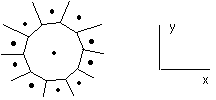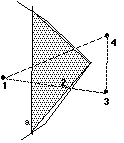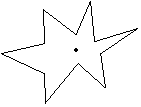 |
 Not a Delaunay Triangulation, but this is a smaller weight. |
| Instructor: Scot Drysdale | July 3, 1996 |
 |
 Not a Delaunay Triangulation, but this is a smaller weight. |
1. What is the complexity of the Voronoi diagram? Take n/2 points around the unit circle in the xy plane. n/2 rings with n/2 faces. The complexity is q(n2) faces . Think of a cut glass vase, a cylinder with n/2 faces on n/2 levels.

| 2. Divide & conquer, get the V diagram of each half, then draw the dividing zig zag
line. Is it possible for the line to cross an edge, then cross it again? Yes, The ant enters point 2's region crossing edge a moves up equidistant between points 2 & 3 hits the edge, moves equidistant between points 2 & 4, hits edge a which shows that it is possible to cross the same edge. Point 2's region is the shaded region. In general, if one point supports both the upper and lower edge of the Voronoi diagram then this can happen. The application in computer programing is that you can't throw away the entire edge because you might cross it again. |
 |
From yesterday:
The convex hull in 3D looks like the Delaunay triangulation when viewed from below,
what maps down is a circle.
The farthest points diagram:
What if you look at the top face? Each of them corresponds to a circle containing
ALL the other sites. This is shown on Page 203. This is the dual of the Farthest
Point Voronoi Diagram, where each point is associated with the point farthest from
it.
(slide 4 from July 2 notes
) Farthest point Voronoi diagram. Region 6 corresponds to point 6, these are all
the points farthest away from point 6. Only points on the convex hull are assigned
regions because if you are inside then you can't be farthest away from any other
point. How can you find the smallest
circle that contains all the points?
| Farthest point V diagram for 2 points |  |
Discussion:
Look at Slide 4 again, How can you find the smallest
circle that contains all the points?
What are the possibilities for the thing supporting the farthest points?
Mary's method,Brute force: find the convex hull, triplets of the convex hull points

Case 1 if 2 points that form the diameter of the set lie on the diameter of a circle
and all other points happen to lie inside that circle then you are done, because
any circle containing all the points must have diameter as large as the diameter
of the set.
Case 2, Compute the Farthest point Voronoi diagram, three regions always meet at every
Voronoi vertex. Compute the radius of all the circles that pass through the three
points whose regions meet at a Voronoi vertex and then take the circle with the smallest radius. (Note that each of these circles is empty.) There are at most n-1 of
these to check. One of the Voronoi vertices is the center of the circle, this is
where you want to locate your rescue station or where you drop the bomb.
If case 1 occurs would the center of the circle be on a segment connecting 2 Voronoi
vertices? Short answer, need not be, but we think that there will be an edge between
the regions corresponding to the endpoint of a diameter. However, we are not sure
and need to consider this farther.
Break.........
----------------------------------------------------------------------------
(slide 1 with overlay 1a
) Voronoi Diagram for a Set of 16 points
What are the nearest 2 neighbors. Every red region contains exactly one black line.
Every edge in the 1st order diagram turns into a region in the 2nd order diagram
Start with the 1st order Voronoi diagram, and say that region 9 isn't there. Split
up the regions and give a piece to each of the neighbors. Refer to the book for more
examples.
Some thing of interest:
With 5 points, start with 1st order, add 2nd where each edge turns into a region.
Then the 3rd order diagram is where you are looking for the nearest 2 neighbors
add the farthest point. The whole bisector in multiple colors appears. Vertices
are never in more than 2 diagrams. The n-1 diagram is the same as the farthest point Voronoi
diagram.
(slide 3)
Vertices appear in 2 consecutive diagrams, once as a nearest type and once as the
farthest type and then they disappear. The K points inside C. V is the vertex that
is the center of the circle.
Facts about order-k Voronoi
The number of Voronoi vertices (of all orders) is O(n3).
The number of unbounded regions (of all orders) is O(n2). (A bounded region in the order-k diagram occurs whenever k points are separated
from the rest by a line.)
(D. T. Lee) The number of close-type vertices of Vork(s) is upper-bounded by: 2k(n - 1) - k(k - 1) - 1 i kvi where vi is the number of unbounded regions in Vork(s). This is O(k(n - k)). Note that because the diagram is planar, O(k(n - k)) is
also the complexity of the entire order-k diagram.
Paraboloid of Rotation
Take the paraboloid, lift the points, at each point take a tangent plane. Standing
at positive infinity assuming that the planes are opaque looking down you would see
a Voronoi diagram. Now put paint remover on all that you can see, you now see the
2nd order Voronoi diagram, again put paint remover on all you can now see and you will
then be looking at the 3rd order... continue till you see the (k - 1) order which
is the farthest point Voronoi diagram. You can get all the diagrams by following
through all the levels. (slide 4
) Every intersection will be a Voronoi vertex on some level. These diagram are nicely
adapted to clustering. Useful for smallest perimeter k-gons, smallest enclosing
k-gons...
-----------------------------------------------------
Another variation on Voronoi diagrams
What if the "unit circle" is not round, as it will be in other metrics?
Unit circle for L1 metric is a diamond, for example:
|
L1 = |Dx| + |Dy| L2 = 2 (Dx2 + Dy2) Lp = p ((Dx)p + (Dy)p) |
 |
(slide 5) another example of the "Manhattan" metric.
Applications:
This is a better model for the pizza parlor problems. You want to find the shortest
distance along STREETS, not as the crow flys, so split up the plane into regions
where the distance is measured by this metric.
Find the largest empty circles, in this case diamonds, the Voronoi vertices are the
centers of these circles.
Suppose you grew triangles from each point until they run into something? Does this
define a metric? No because you run into certain problems.
"Expanding Waves" idea leads to a distance measure: think of any convex shape as
the "unit circle" and some point inside it as its "center."
(If the circle is not convex this gets messy.) Because this is not symmetric it is
not a metric, however it does have everything else. Studied in 1911 by Minkowski,
Convex Distance Functions, have all properties of a metric except
symmetry. In particular: Triangle Inequality holds. (strictly
if not flat side).
This region is star shaped, definition of star shaped is that from a particular point
every line segment drawn from that point to another point in the region lies entirely
in the region.

Supplemental notes:
The following information was provided by last evening's speaker on VERTEXTILES.
Chris K. Palmer
Route 3 Box 72 K
Davenport, WA 98814
Bay Area Rapid Folders Newsletter
Membership $15 a year $20 outside US
4 issues a year
Back issues for members $2.00 plus $2.00 postage & handling ($3.00 overseas)
non-members $4.00 (except Mar $10)
Check payable to Jeremy Shafer
Send check to: BARF
c/o Jeremy Shafer
1733 Virginia St
Berkeley, CA 94703
I've enjoyed working with the teachers and researchers the past two weeks here at DREI
and I am sorry to be leaving but I have a commitment to the LP program at Dimacs
for the next two weeks. I hope that you will all keep in touch with me and with
each other through e-mail, web pages, telnet-talk, and the bulletin board on the DREI page.
Remember that unless you use what you have learned you will loose it.
Thanks for sharing this time with me.
Judy Ann Brown <judyann@dimacs.rutgers.edu>
home page: http://dimacs.rutgers.edu/~judyann